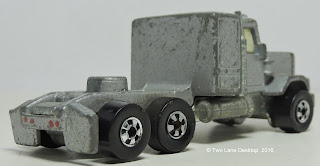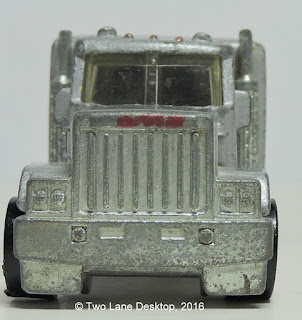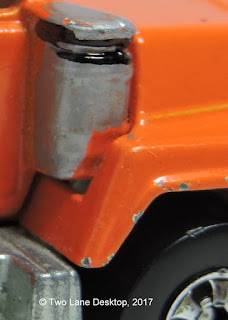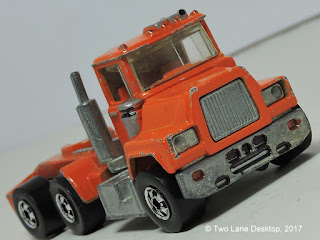Hot Wheels Convoy's, part 1: The Steering Rigs
One of the most common topics in a discussion with Hot Wheels collectors is how heavy is a particular casting. Believe it or not the hype of ligher weight means faster concept applied to real vehicles does not apply to Hot Wheels because the toy cars use gravity to obtain the quickest speed down the track. Of course there are times when there is too much mass for track duty, and one of them just happens to be large trucks or tractor cabs. In this two-part series I take a look at the big rigs of the Hot Wheels line throughout the years. Now there are a few others that I left out including the Kenworth C.O.E. steering rig (you'll see why later) and the Peterbilt trucks that range from a dump truck to a metal tanker body (i'll look into those castings at a later date). The first is the unique and highly sought-after Steering Rigs models.
I thought the idea of the Steering Rigs was a good idea: introduced at the time long haul rigs were popular in culture leading to movies like Smokey and the Bandit and Convoy. By the 1970's the trucks were bigger, bolder, stronger, and some having a sleeper cab just behind the front cab area for long-travel hauls. Around this time big rig castings were starting to appear more frequent in diecast. Hot Wheels got into the action in the early 1980's with castings such as Thunder Roller (a Kenworth COE) and Long Gone (a custom Peterbilt), with the biggest introduction being the Steering Rigs in 1982. The setup here is that each set has a tractor cab that comes in six versions: GMC, White, Ford LTL, Kenworth COE, Peterbilt, and Mack. Each truck cab is made on a metal body with a metal base with slots in the fifth-wheel hitch to attach various trailers. Notable additions to the Steering Rig cabs are a separate slot for the steering arm to rotate the cab and the front wheels of the dual rear wheels have a rubber compound to hold the cab still while it rotates side-to-side (without it the cab would not turn). The trailers come in various styles ranging from typical box freight to tanker styles and all of them have a closed-in setup to allow the steering contraption to hide inside. Using a rubber band connected to the steering wheel at the top of the rear part of the trailer the rotation is then transferred to the front steering tab to cause the cab to turn at a given direction. Also on the front of the two rear wheels on the trailer is the same rubber compount found on the front-rear axle on the cab.
The idea was to allow a child to push the truck forward and then when it comes time to turn the steering wheel would turn the cab in a given direction and the trailer, in tandem, would follow the cab in the same direction. The idea was very neat, but once again it's hard to gauge a child's marketing selling points (look how a simple fidget spinner becomes popular despite hundreds of them out there now) and the trailer set only lasted two years. In addition in 1984 the cabs were sold separately in blister without the trailer, a Bigfoot trailer set used the Ford LTL cab, and there was even a car transporter as part of the color changers line; the last two do not have a rotating mechanism in the trailer. Even as Hot Wheels still makes haulers today they are no where near the level of the original Steering Rigs in style (realistic cabs and trailers) and pure weight (all metal cabs). Today the cabs and trailers are right up there with Redlines of the late 1960's and early 1970's for top-dollar prices and high demand. So how did I managed to get all five in one year? Patience was one to wait for the right time at the right prices and so far I managed to range between $1 each for two found at the Flea Market to $110 for a mint White Cab and Cattle trailer that comes with the box that is in rough shape.
I was surprised and hooked to find the first two at a Flea Market: a yellow Ford LTL and a red Peterbilt cabs, both for $1 each. A steal considering the demand for these two! The castings were far from pristine as both have paint chips, bent wheels (very easy to straighten out), the Peterbilt has a bent-back left headlight, and the Ford LTL had some casting issues as the left-side headlight does not align correctly with the hood. Otherwise both are in great shape for such playworn castings. Shortly after that I added another Steering Rig, the GMC with the Eagle trailer, my first Steering Rig trailer. This GMC/Eagle trailer combo is very common so prices for these are reasonable. Note the box trailer has an opening blue door on the left side (some later versions have the door closed off and molded with the trailer). It took a while to get the other two when one day I managed to find the Mack with the white cattle hauler from the same Ebay seller as the GMC and won the auction; both came in at the same price range of $30-40. Finally, A 20% discount on a White cattle truck that was mint and comes in a rough box was the finishing touch to the set. Now what about the Kenworth COE? I passed on this one because the Rolling Thunder casting is the same Kenworth COE style, but larger and with a sleeper cab in the back.
The Peterbilt is known as the 359 and was the classic shape of Peterbilt trucks in the 1970's and early 1980's. The front has a tall grille with round logo on the top, leading down to the lower bumper and attached to the sides is four round headlights in an oval housing. The hood has that butterfly opening look even though the hood now opens forward. The round badges also appear on the sides of the hood next to the large air cleaner and round front fenders. The cab has a split window setup with a V-shape to them, A/C system on the roof next to the horns and clearance lights, and doors that have an additional window near the floor for better visibility. Fuel tanks are under the sleeper so more clear step boxes into the cab can be added, and just ahead of the sleeper is the usual dual stack exhaust on each side. Like most other trucks here the dashboard is angled toward the driver and contains a lot of switches and gauges to monitor and control, a large 3-spoke steering wheel, two seats with air support, and the shifter on the floor. The sleeper cab provides enough room for overnight stops. All of these trucks carry a turbodiesel I-6 that can produce torque well over 1,000 Ib's and controls that torque through a manual transmission that can have up to 16 gears to go through. The shifter is in a 4-speed H-pattern, but the extra gears are added by a high and low gear level at the front of the shifter and primary/secondary switch to the left of the shifter. Reverse can use these levers to create four different reverse speeds.
Ford and GM have tipped their toes in the commercial truck business by entering the 1970's with six-axle big rigs called the Ford LTL and GMC General. The Ford served for two decades before being sold off to Freightliner as the Sterling line in 1998. The LTL uses the boxy Ford Truck look that has a large slightly polygonal grille with a center stripe that has the Ford letters running across. The square headlights are merge into the front fenders, which are integrated into the hood. The L-series would be know for the hood side vents, with later models adopting a round, almost turbo-like intake side scoop. The cab is flat and modern with the sleeper just behind sitting nearly even with the front cab. Fuel tanks are just below the front doors and the rear wheels have a front tire guard. The cab inside has a great detail of details with the angled dashboard, steering wheel, and seats; the most detailed interior of the group. On the other side is the GMC General that has the same hood and cab design as the Ford LTL, but with more prominent side steps including one for the left-side rear fuel tank. The front hood has a more angled look like the Peterbilt and also has the lower side windows on the doors. The front grille uses vertical bars going across, the headlights are in large rectangular housings, and the lower bumper has flaps to protect the front wheels. I added GMC to the grille. The interior has a basic layout with seats and a not-so-detailed dashboard, while the windshield has a split look even though it looks more like a one piece unit.
The Eagle trailer is based on the typical box trailers and has that realistic look with the proper details added by Eagle trucking on the sides and on some models an opening side door. The cattle trailers are taller, boxy trailers with a gridded design for the bars even though this is an enclosed trailer. One says Western on the sides while the other says Straight Arrow, and note the door in the rear that on the left allows for a sliding block panel to come down when all of the cattle has been herded into the trailer. The White is a unique casting to do: by the time Hot Wheels made this White cab the remains were sold off to Freightliner and Volvo. Earlier trucks were well-known for the White motor company and well-respected in the industry. It is sad to see how far this company has come from the upside to the selling off of the company. It is evident in this red cab; look close and you could mistaken this White for the Peterbilt! The front grille is the largest of the group and has a split pattern with WHITE letters engraved on the top. Headlights are square and attached to small side fenders. The top of the cab has nice details of the lights, horns, and grid stamps, and this truck only has one side exhaust stack on the right-side. The fuel tanks are large and span the width of the cab and sleeper. The interior is nicely done and one of the best of the bunch with detailed seats and controls on the dashboard.
The last truck is the unusual Mack V-900 in orange. It is the only truck in the group without a sleeper behind the cab, though it's compact size does allow better manuverability of the group. Mack is another well-known trucking company with the famous bull dog hood ornament, and they offer stylish trucks, but by the 1970's the trucks got boxy and rather odd: this model shown here has the cab off-set to the left to allow better visibility at the expense of cab design. At first I thought it was odd for Hot Wheels to do a cab that is designed to handle longer loads (like pipe or rubar metal) on the right-side of the cab, but it turns out it was an actual Mack design that was controversial at best. The front has a square grille with vertical bars, round single headlights in rectangular housings where the inner sections can have optional foglights on some models. The lower bumper has the most relief holes and lights of the group. The hood is a separate piece from the cab, yet still this truck is all-metal. The left-side cab has a large side door with integrated step and inside the interior is part of the metal hood section. The air cleaner and single exhaust stack reside on the right-side of the truck. At the rear you can find detailed frame and driveshaft information and even a toolbox against the cab.
Pictures are nice, but even better is experiencing them in person to get the feel of the heft of these cabs and how seamlessly the steering rig operation still works after all these years.
Update 12/1/19: After a bit of a delay and some decision making, I finally decided to finish off the six-cab set of the Steering Rigs with this Kenworth COE in blue and made in France. The exterior has the familiar square cab-over engine look of the Kenworth with detailed rivets, side steps, dual rear exhaust stacks, and the tall split grille. Even the Kenworth badge is visible on the sides just below the front doors. The headlights are part of the metal base and for some reason they do not align flush with the cab as the gap between them is very noticeable. The interior has front seats in tan, but no dashboard with a rivet post between the seats, and while it has a sleeper cab it lacks the aero cowl on the roof that Thunder Roller has. Overall a nice casting that stands out from the typical cabs of this Steering Rigs set:
















































































































Comments
Post a Comment